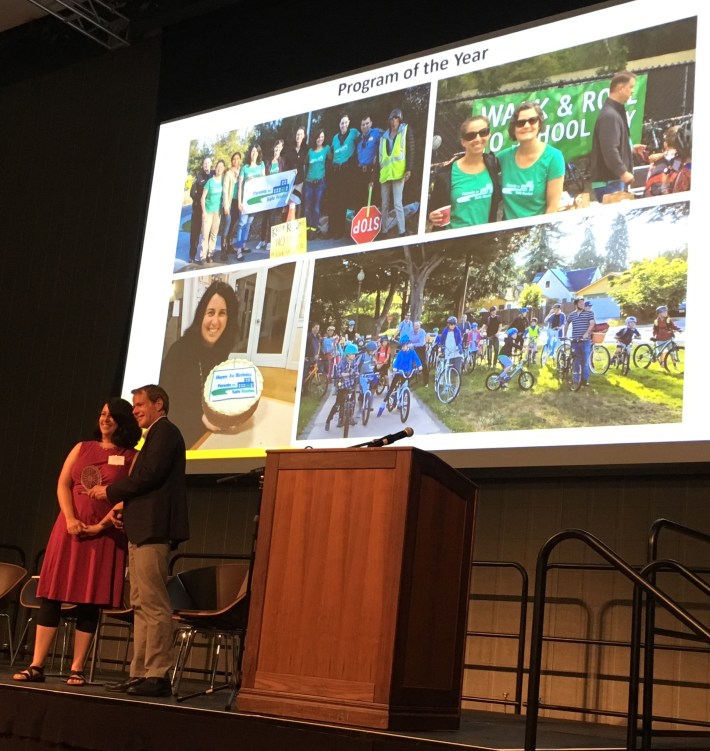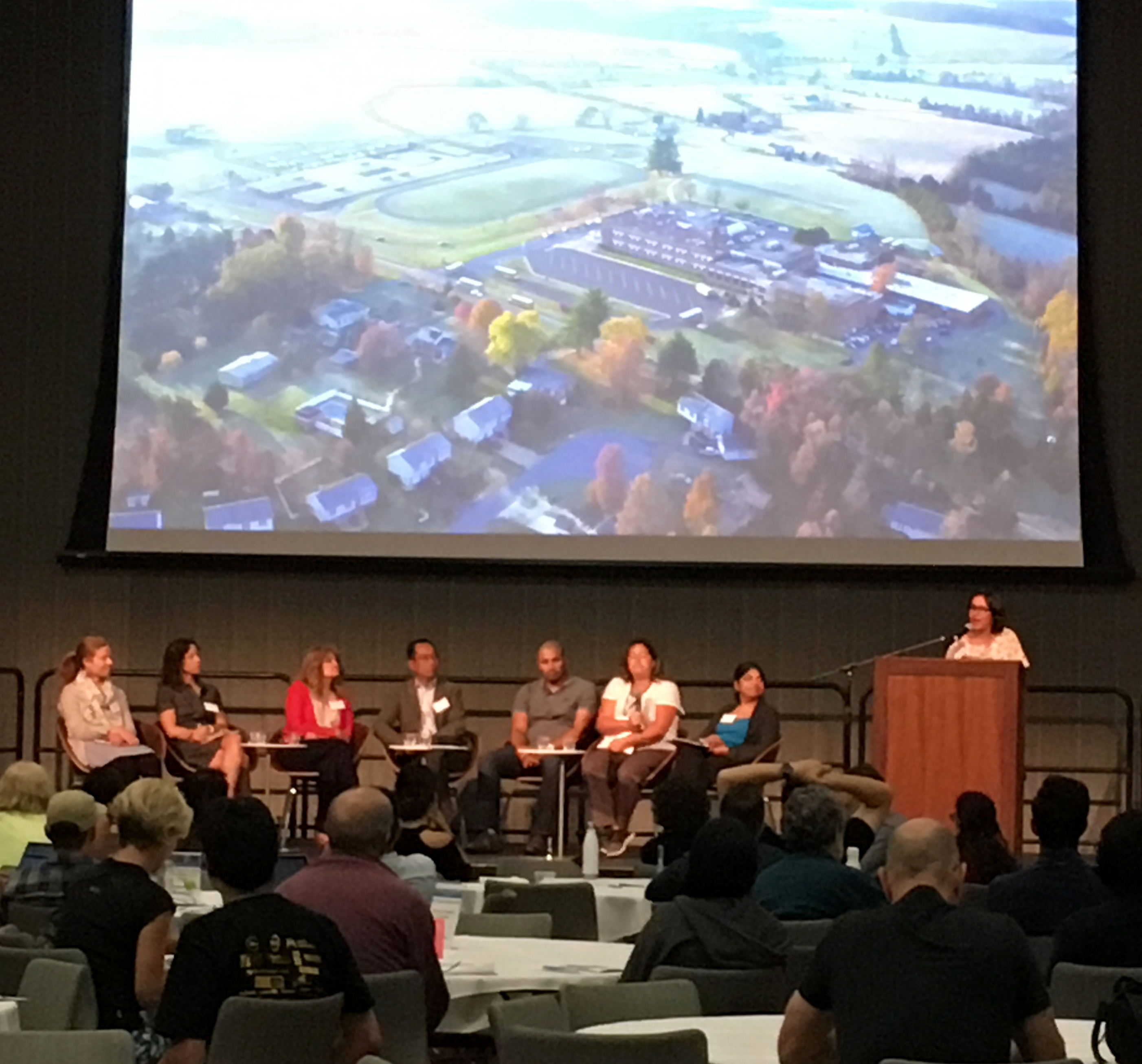Note: GJEL Accident Attorneys regularly sponsors coverage on Streetsblog San Francisco and Streetsblog California. Unless noted in the story, GJEL Accident Attorneys is not consulted for the content or editorial direction of the sponsored content.
The Silicon Valley Bike Coalition held its annual summit yesterday, a day of information sharing for people working in the Bay Area, and particularly the South Bay, on safe, reliable, sustainable transportation planning.
As would be expected, attendees included a wide range of bike and community advocates, bike enthusiasts, city and county planners, and representatives of related industries. It was a beautiful day on the San Jose State University Campus, which was swarming with students in the second week of classes.
The summit was very easy to get to. It was close to the San Jose Diridon station, which is served by Caltrain, Amtrak, buses, and bike-share—and there were several e-scooters for the taking as well. Indeed, it felt very urban-chic to hop off the train and join a bevy of other attendees for the short ride along well-marked bike lanes into San Jose's downtown core for the event.
The crash between two Ubers we witnessed along the way did nothing to damage this first good impression of San Jose's evolving bike infrastructure.
The summit lived up to its promise of providing lots to think about in terms of planning and progress and work still to be done to make life better for bikes, not just in the South Bay but everywhere. One of the compelling talks was about equity, and specifically about engendering better public involvement in planning for bike facilities. Presenters talked about the importance of getting input from people who currently ride as well as people who are interested in riding but may be wary or just plain scared to try because of gaps in the current networks.
But that's not so easy, as clearly illustrated by two different presentations, one from Caltrans D4 Pedestrian and Bicycle Coordinator Sergio Ruiz and the other from Lauren Ledbetter, Bicycle and Pedestrian Program Manager for the Santa Clara Valley Transportation Authority.
Both planners had recently completed bike plans for their jurisdiction. They discussed the ways they gathered feedback from the public, which included public meetings and workshops, booths at pop-up events, and an online map on which people could pin good and bad areas and describe obstacles and challenges in those areas. The map seemed like a great idea; it was relatively inexpensive, accessible to anyone with an internet connection at all hours, and seemed to have the potential to gather feedback from a wide range of bike network users. But both Ruiz and Ledbetter showed charts that illustrated a fatal flaw in relying on online feedback: by far most of the people who weighed in on the maps were older white men with high incomes.
The information gave them pause. It's not that input from experienced older white male bike riders is useless, but they had hoped to hear from a wider range of people--and they had hoped that an online shortcut would help make it possible do to so inexpensively. Ledbetter pointed out that outreach can take up twenty to thirty percent of a plan's total budget.
But a presentation from Zelica Rodriguez-Deams at the same session held some hints about just how difficult and time consuming—and worthwhile—true public engagement is. She talked about the work of SOMOS Mayfair, a community group in East San Jose that not only gathers people to talk about issues from transportation to education, but also trains community members to become leaders and do the same work themselves.
Rodriguez-Deams outlined a philosophy of engagement that the group has developed over time and with hard-won experience. Their first principle is that people check their privilege. This applies, she said, to everyone, because before you can listen deeply you have to recognize they ways you have advantages others may or may not share. Even those who don't think they are privileged have some advantage, even if it is just understanding the material they want to present.

Other important principles including building trust through clear expectations, supporting a sense of belonging, and recognizing leadership. Also, she pointed out that “it's important to get people to engage sustainably over time. It doesn't make any sense to have a single meeting and expect to get everything done.”
SOMOS Mayfair's hard-learned lessons contrasted strongly with the presentations by the government agency reps, who have to conduct their public outreach with limited time, limited funding, and usually only a surface knowledge of the communities their plans affect.
So how can government agencies do a good job? Megan Wooley-Ousdahl, a project planner with Toole Design, offered a middle way. She gave the Oakland Downtown Specific Plan as an example of a successful public process. At the beginning of that process, planners came up with a draft plan that looked very planner-y and seemed aimed at encouraging new residents rather than celebrating or engaging current residents.
After pushback from some community groups, she said, the city put a hold on the planning process while it searched for a way to be more inclusive and to bring in the community from the beginning. Ultimately, the city created an advisory group that started the process anew, and the community-led draft plan looked very different, even in name: it is now called Equity in Downtown Oakland.
By giving equity top billing, she said, the plan makes clear what its focus and priorities are, and every decision in it is made with equity as a top consideration, rather than as an afterthought.
A different conversation kicked off the summit. Planners from local cities and regional agencies joined industry representatives to talk about new mobility technology and what they might mean for the future of transportation. Bike-share, electric scooters, and ride-hail are now available in many California cities, and definitely in San Jose, and they need to work within a context of existing transportation infrastructure.
Jason Islas, of Bird Scooters (and formerly of Streetsblog sister site Santa Monica Next), pointed out that many of the controversies that have arisen with new technologies have been due to their rapid deployment. In Santa Monica, e-scooters “added people to the streets at a human scale very quickly. When mode shift happens quickly, there are some rough edges,” he said. But the mode shifts happening in Santa Monica—with the extension of Metro, the adoption over time of bike-share, and then the sudden addition of shared e-scooters—are also creating a new experience for people. They are moving through the streets in a new way, some for the first time, he said.
And the controversies over scooters on sidewalks and in bike lanes are happening in part because “we're arguing over ten percent of the streetscape. Ninety percent of the street space goes to cars,” he said, “which are inefficient and not at a human scale.” He compared transportation systems to ecosystems, saying they are healthier when they are more diverse, with a wider variety of options for people to move around.

Ria Lo, transportation manager for the city of Mountain View, said that that city's public outreach showed them that people want new transportation technologies to match city and county goals on sustainability, equity, and the like, without compromising other goals and without leaving behind people who can't afford them in their current forms. Work on the city's protected bike infrastructure to accommodate everyone who wants to ride or walk, she said, is even more critical with new technology coming on board.
Meanwhile, having larger goals is crucial. “Goals help overcome institutional inertia,” she added.
The bike summit, which took place at the San Jose State campus in downtown San Jose, featured many more conversations and discussions about topics from Vision Zero to new engineering strategies for planning and building safe bike infrastructure. It wrapped up with an inspiring panel on getting more people biking through encouragements of all kinds, from allowing bikes on transit to building more bike parking to expanding bike trails to incorporating biking into school curriculum.
TransportiCA tweeted out many of the speaker topics (@TransCAEvents), and also recorded and streamed the talks, which can be accessed at their YouTube channel here (with more videos coming as they are edited).






